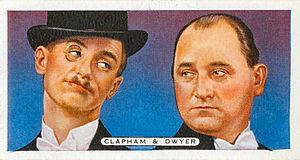 | ||
A days broadcasting clapham and dwyer novelty gramophone recording digitally restored
Clapham and Dwyer, Charles Clapham (1894-1959) and William Henry Dwyer (1891-1943), were a British comedy duo in the 1920s and 1930s.
The duo were a popular music hall and stage act, appearing in venues all over the country. As part of their act in 1929 they originated the Cockney Alphabet, a humorous alphabet that replaces the letters of the alphabet with cockney phonetics, such as "A for ‘Orses" (Hay for Horses) and ending with "Z for Effect" (Said for Effect). In February 1929, they appeared in two early short films made in the Lee DeForest Phonofilm sound-on-film process. They also appeared in their own scene in the early Will Hay film Radio Parade of 1935.
Just after World War II they were banned by BBC Radio for six months for allegedly broadcasting an improper joke. The duo had a regular spot on the BBC’s Light Programme which was broadcast live. It is said that when they discovered that a page of their script was missing they ad-libbed:
"What’s the difference between a champagne cork and a baby?” asked Clapham. When Dwyer replied that he didn’t know Clapham retorted: “A champagne cork has the name of the maker on it."
Such material was considered rather risqué at the time. However, there are differing accounts as to what the joke actually was.
